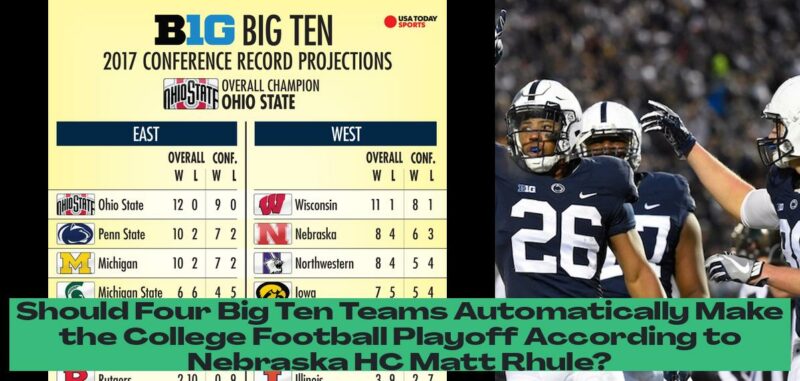Nebraska HC Matt Rhule thinks four Big Ten teams should make College Football Playoff
Matt Rhule, the head coach of the Nebraska Cornhuskers, has made a bold statement about the Big Ten Conference’s place in the new 12-team College Football Playoff. During his appearance at Big Ten media days, Rhule declared that he believes the conference should automatically earn four bids to the playoff each year. This statement reflects Rhule’s confidence in the Big Ten’s strength and depth, and it has sparked a debate within the college football world.
The new 12-team playoff format, which takes effect this fall, has drastically altered the landscape of college football. It replaces the old four-team system, which often left deserving teams out of the national championship conversation. The new format is designed to be more inclusive, with the top five conference champions and the next seven highest-ranked teams earning a spot in the playoffs. The top four teams receive a bye in the first round, while the remaining eight teams compete in a first-round knockout bracket.
Rhule’s assertion that the Big Ten should get four automatic bids is a testament to his belief in the conference’s dominance. He sees the Big Ten as the “NFL of college football,” suggesting that the conference’s talent level, competitive intensity, and overall strength rival the professional league. He points to the conference’s vast geographic footprint, which stretches from coast to coast across different time zones, as further evidence of its depth and diversity.
Rhule’s belief is not simply a matter of opinion. The Big Ten has consistently produced some of the nation’s top teams, and its recent performance has only solidified its position as a powerhouse conference. In last season’s final poll, Washington finished second, while Oregon came in seventh. Ohio State, Penn State, and Iowa also cracked the top 25, and Michigan went undefeated, winning the national championship. These results show that the Big Ten is capable of consistently fielding multiple teams that can compete for a national title.
Rhule’s vision for the Big Ten in the new playoff format aligns with the conference’s current trajectory. With the addition of four new teams — Washington, USC, UCLA, and Oregon — the Big Ten is poised to become even more competitive and dominant in the coming years. These additions increase the conference’s overall strength and provide additional opportunities for teams to earn high rankings and playoff berths.
- Nebraska HC Matt Rhule believes that four Big Ten teams should automatically make the College Football Playoff each year.
- Rhule’s statement reflects his confidence in the Big Ten’s strength and depth in college football.
- The new 12-team playoff format aims to be more inclusive, with top conference champions and highest-ranked teams earning playoff spots.
- Rhule sees the Big Ten as the “NFL of college football,” highlighting its talent level, competitive intensity, and overall strength.
- The Big Ten has consistently produced top teams, with multiple schools ranking high in national polls and competing for championships.
- Rhule’s vision aligns with the Big Ten’s trajectory, especially with the addition of new competitive teams like Washington, USC, UCLA, and Oregon.
The Big Ten’s Case for Four Playoff Bids
Rhule’s call for four Big Ten teams in the playoff is not without merit. The conference has a strong case, supported by its history, current talent pool, and future prospects.
The Big Ten’s history speaks for itself. The conference has produced numerous national champions, Heisman Trophy winners, and other top-tier players. Its tradition of excellence is undeniable, and it has consistently been a major player in college football. The conference has consistently produced top-tier players and has been a major force in college football. Its history is a testament to its strength and longevity.
The Big Ten’s current talent pool is arguably the best in the nation. The conference boasts several top-ranked programs, including Ohio State, Michigan, Penn State, and Wisconsin. These teams consistently recruit top talent and have the resources and coaching expertise to compete for championships. The addition of USC and UCLA further augments the conference’s talent pool, making it even more formidable.
The Big Ten’s future looks bright. With the addition of four new teams, the conference is poised to become a national powerhouse. The new teams bring a wealth of talent, tradition, and national recognition, further strengthening the conference’s overall profile. The Big Ten’s expansion and continued commitment to excellence will ensure its future dominance in college football.
The Big Ten’s case for four playoff bids is compelling. The conference’s history, current talent pool, and future prospects are all strong indicators of its dominance. Rhule’s belief in the Big Ten’s strength is shared by many in the college football community. While getting four teams into the playoff might be a lofty goal, the Big Ten’s position as a power conference gives it a strong foundation for achieving this objective.
The Challenges of Four Big Ten Teams in the Playoff
While Rhule’s vision of four Big Ten teams in the playoff is appealing, it is not without its challenges. The new 12-team playoff format is still relatively new, and its long-term impact on college football is yet to be fully understood.
One of the biggest challenges is the potential for conference bias. If the Big Ten gets four automatic bids, it could create an imbalance in the playoff field. Other conferences, such as the SEC and the Pac-12, might argue that they are equally deserving of multiple bids. This could lead to resentment and controversy, undermining the spirit of fairness and competition in college football.
Another challenge is the potential for diluted value. If too many teams from one conference make the playoff, it could diminish the prestige and excitement of the event. The playoff’s appeal lies in the convergence of the best teams from across the country, creating a sense of anticipation and drama. Having too many teams from one conference could create a sense of predictability and reduce the overall excitement of the playoffs.
The Big Ten’s expansion also presents challenges. While the addition of four new teams strengthens the conference overall, it also increases the competition for playoff berths. With more teams vying for a limited number of spots, the race for a playoff berth becomes more intense and unpredictable. This could lead to a scenario where only a few Big Ten teams make the playoff, despite the conference’s overall strength.
Despite these challenges, Rhule’s vision of four Big Ten teams in the playoff is an ambitious but achievable goal. The conference’s history, current talent pool, and future prospects are all strong indicators of its dominance. With a continued commitment to excellence, the Big Ten can make a strong case for its teams to be consistently represented in the College Football Playoff.
The Future of the Big Ten in the 12-Team Playoff
The Big Ten’s future in the 12-team playoff is uncertain, but it holds great promise. The conference’s expansion, combined with its continued commitment to excellence, makes it a strong contender for multiple playoff berths. The new format allows for more teams to participate, increasing the chances of multiple Big Ten teams making the playoffs.
The Big Ten’s strength will be tested in the coming years as it navigates the new playoff landscape. The conference’s ability to adapt and compete at the highest level will determine its success in the 12-team playoff era. The Big Ten’s future in the 12-team playoff is a story that is still being written. The conference’s performance in the coming years will determine whether Rhule’s vision of four Big Ten teams in the playoff becomes a reality.
The Big Ten’s future in the 12-team playoff is a story that is still being written. The conference’s performance in the coming years will determine whether Rhule’s vision of four Big Ten teams in the playoff becomes a reality. However, one thing is certain: the Big Ten is a force to be reckoned with in college football, and its future in the 12-team playoff is filled with potential and promise. The conference’s history, current talent pool, and future prospects all point to its continued success and dominance in the years to come.









